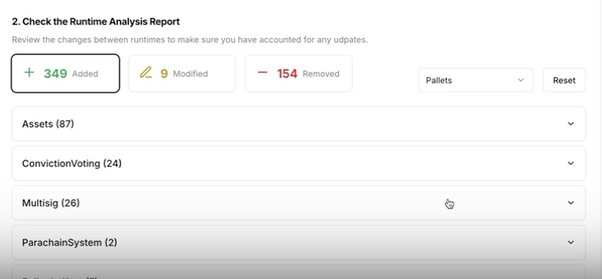Polkadot Deployment Portal: July Upgrades
In July 2025, the Polkadot Deployment Portal (PDP) received a set of significant upgrades, all focused on empowering builders. These enhancements put you in control, reduce friction, automate key setup steps, and bring visibility into the runtime environment, making it easier to launch with confidence.
You are now more empowered than ever, whether you’re launching your first testnet or scaling a production-grade rollup. Let’s take a closer look at the new features of the Polkadot Deployment Portal and the advantages they bring builders.
TL;DR
In July 2025, PDP received key upgrades to make launching and managing rollups on Polkadot even easier:
-
PDP now uses Kubernetes (K8s) for every rollup infrastructure, giving more control and scalability.
-
Runtime diffing tools to preview and validate upgrades.
-
Automatic Coretime renewals to prevent rollup downtime.
These changes dramatically reduce setup friction, improve upgrade confidence, and keep chains live without manual intervention, making PDP the fastest and most reliable way to launch rollups on Polkadot.
This means you can spend less time on setup and more time on building, making your development process more efficient and productive.
Kubernetes now power PDP deployments
By shifting to K8s for rollup deployments, PDP can now offer a more dynamic and modular infrastructure setup for each project. This means that every rollup launched through PDP benefits from a containerized, production-grade environment that can easily scale based on demand, integrate new services seamlessly, and adapt to evolving technical needs.
For developers, this translates into real-world advantages:
-
Customizability: Teams can extend their infrastructure to include essential tools or services.
-
Scalability: Applications can grow more reliably without needing to re-architect infrastructure.
Kubernetes isn’t just a backend improvement; it’s a strategic foundation for giving builders the control, visibility, and extensibility they need to go from testnet to production with confidence.
Runtime Upgrade Visibility: Know Before You Deploy
Upgrading your runtime is a critical moment. Mistakes can be costly, and uncertainty creates friction. To make upgrades safer, the PDP now provides visual diffing for runtime changes, leveraging the new library from the PAPI team.
That means:
-
Before you hit deploy, you’ll see exactly what’s changing.
-
Runtime diffs highlight logic changes, added/removed pallets, and config updates.
-
You can roll back or adjust based on what you see.
This transparency helps reduce risk, increases trust in the deployment process, and makes runtime iteration much more developer-friendly.
Auto Coretime Renewals: No More Expired Blockspace
Previously, builders needed to monitor their coretime allocation and manually renew it before expiry, or risk their rollup going offline. In July, PDP introduced automatic coretime renewal.
-
PDP now keeps your rollup active by automatically renewing blockspace as needed
-
You get clear notifications about renewal cycles
-
No more worrying about downtime or missed deadlines
This upgrade makes production deployments smoother and ensures high availability for mission-critical rollups.
Why This Matters
With these upgrades, the Polkadot Deployment Portal is fast becoming the go-to launchpad for rollups. Together, these features streamline the journey from idea to deployed chain in just a few clicks.
Whether you’re:
-
Experimenting with new runtime logic
-
Launching a gaming rollup with built-in messaging
-
Building DeFi apps with custom blockspace strategies
Polkadot Deployment Portal (PDP) makes it easier to bring your project to life, with built-in scalability and secure multichain messaging from day one.
Try It for Yourself
→ Register for PDP beta testing
→ Follow @PolkadotDeploy & @paritytech for updates
→ Join TG channel https://t.me/+aVPu-gy9gYAyYWM0
